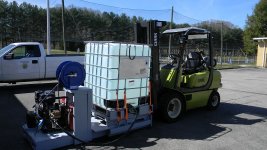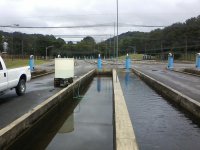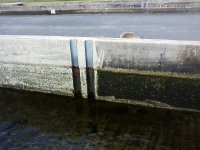One caveat, as if the 1st post wasn't enough, we could draw on those 6" pipes either directly or indirectly. Directly would mean plumbing spigots into the 6" pipes and setting up this way would mean that we would have to run our supply line to wherever we put in spigots, as it probably wouldn't be economically feasible to put a spigot in all 52 pipes or even to 1/2 of them (the pipes are near each other in pairs). But by indirectly I mean that it could be possible, if equipment is available to handle it, to draw from the pools created by the pipes. But the pools contain water contaminated by the fish raceways upstream from them that flow into these pools. There are no fish in these pools, but there is fish crap, uneaten feed, and algae. This means that those pools are probably five times more dirty than the relatively cleaner water coming straight from the reservoir 95' down from the water surface of the dam and so beefier filters would have to be built in than simply filtering lake water. Also, if drawing from the pools instead of tapping in to the pipes, the water has to either be drawn by or pushed out against gravity by pumps, as we do with our truck-fill pump, to supply the pressure washer. Whereas tapping in to the pipes, which are gravity fed and reduced down from larger pipes, they would have considerable PSI and even more if they were reduced down to smaller spigots or valves supplying a pressure washer.
You are using an out of date browser. It may not display this or other websites correctly.
You should upgrade or use an alternative browser.
You should upgrade or use an alternative browser.
Large machines
- Thread starter Rsuds
- Start date
Sorry for the late reply. I tried posting earlier, but it didn't take...
Upper Cumberland Region in Northern, TN. East-West--about 1/2 between Knoxville and Nashville; North-South--nearly due north of Chattanooga in Clay County, which borders Kentucky. Very rural area. I live just one county south of Clay County, which is closer to a little bit of a population center--a town called Cookeville.
Upper Cumberland Region in Northern, TN. East-West--about 1/2 between Knoxville and Nashville; North-South--nearly due north of Chattanooga in Clay County, which borders Kentucky. Very rural area. I live just one county south of Clay County, which is closer to a little bit of a population center--a town called Cookeville.
gear junkie
New member
Sounds like what you may be looking for is a trailer sewer jetter. They used to be made huge with 600 gal tanks 80gpm 2000psi. Now nozzle technology has improved, 18 gpm 4000 psi 300 gal tanks are the big guys.
Here's an example..... http://www.ebay.com/itm/96-SHAMROCK...596?pt=LH_DefaultDomain_0&hash=item339ff15dac
Here's an example..... http://www.ebay.com/itm/96-SHAMROCK...596?pt=LH_DefaultDomain_0&hash=item339ff15dac
Thanks for the link. That really gets me thinking...
That big boy would work as long as we could figure out a way to tap in to our 12000 GPM, gravity-fed, reservoir water at multiple locations in serial and run it into a water tank and then to the pump without an issue using slightly turbid water as source water. I'm sure filtering the settle able solids would be quite easy with a 30 or 50 mesh strainer upstream of the tank and another one or two 50 mesh strainer between the tank and machine, but I don't know how this machine (or any other for that matter) can deal with dissolved metals or any other dissolved solids that are in our reservoir water. I can say that for a reservoir it is very clean, which makes it a real trick for fishermen, because it's so clear, and that the water comes through a large basket strainer from 95' below the surface at the dam (not surface water), but that strainer has about 1" holes just to keep out really big fish, branches, etc.
The main thing we get through our pipes is partially-broken-down pieces of wood that wash off the banks of the lake and sink down in the water and then are drawn to the dam where it enters our intake. The algae doesn't start until after the water is aerated at our hatchery, so we'd be tapping into it before the aeration occurs. The dissolved metals come around only in the Fall, just before the reservoir stratifies; but most of the time, the water is very clear.
This is the main reason I've turned to you pro guys. I've not had anyone offer me solution ideas for using my reservoir water as a water source. If I can find that solution, and have it backed up by experts, then I can convince my supervisor and push for spigots along our gravity-fed, 6" supply lines that run in serials through our hatchery. In that scenario, we could get by with as few as six spigots and 150' of garden hose and options really open up at that point from 4GPM-18GPM and beyond. Our city water is paid for by the US Army Core of Engineers, who we lease our land from, so we can't expand our use or add lines w/o their approval and w/o taking on the responsibility of paying for that utility. I don't think that will happen, plus we have only around 6 gpm and even less if someone flushes a toilet.
The issues keeping us from getting a bad boy as posted, not counting the money budgeted for it are:
(1) Being a federal gov't field station, we can't buy used stuff, or at least that's what I've been told.
(2) We don't have room to store that unit under cover, so in order to protect our investment, we'd have to contain it in a box-style trailer or something similar. I found this link but no price: http://usjetting.com/pdf/4018-300-enclosed-trailer.pdf
(3) We have to work out the water supply issue, because if I've got a 300 gallon tank that is not being filled as it is being dispensed, and if it is being dispensed at a rate of 18 GPM; we're not going to be able to get any work done.
(4) I don't know much about a sewer jetter system. I know that they're used for cleaning drains, but I'm not sure what they do exactly and how they are setup and what the differences are between those and regular PW'ers. I just need to spray a solid stream; not pulse. I need only about 75' of pressure hose, because much more would just in the way and extra bulk; and I need as large a swath at a time when I spray to scrub and rinse concrete quickly.
At the floor of our raceways, even if we block all the water we can, we'll have some water get through and we'll have about 1/2" deep (upper end) to 2 1/2" deep (lower end) flowing along the floor. A pressure washer has to blast under that water and scrub algae below it and have enough GPM to help rinse it away. The algae may be an 1" thick on the floor and so as one sprays it moves the bulky stuff a little ways and it builds up as one moves down the raceway. We also clean the walls which is much faster work, but the walls are even thicker with algae, so when it comes off it adds to the build up on the floor. One technique is to block as much water as possible and do the floor first; then pull the blocker up slightly to let more water run through while doing the walls. This gives more rinsing power and will flush most of it down the drain while spraying, but we'll still have to either do a final flush with the pressure washer, or even faster, use a brush to push the remaining big heavy stuff down the drain.
Previously, we had two 2.4-gpm, DD, 3000 PSI units. It took around 2 hrs, with two people using two units. The units would last us about a year-and-a-half. Nowadays, it takes about two hours with one person using a 3.7-gpm, BD, 3500 PSI unit. Before, we used 25 degree tips. Nowadays, with the bigger unit, we're using a 40 degree tip. At 3.7-gpm, even though we're going much faster, we're using slightly more water than with the old units. So our 330-gallon tote is just barely enough to do one raceway, and so I feel we've reached our limit until we get a better supply solution.
We've tried a sweeper, but at least the one we have doesn't scrub the algae very well and it's not been worth hauling it around. A trolley lance with mulitple tips might be a good idea or even a sweeper, once we have enough GPM to give them more power. I've thought about a turbo tip, but I've had trouble visualizing how one of those would give us a really large swath to do quick work.
That big boy would work as long as we could figure out a way to tap in to our 12000 GPM, gravity-fed, reservoir water at multiple locations in serial and run it into a water tank and then to the pump without an issue using slightly turbid water as source water. I'm sure filtering the settle able solids would be quite easy with a 30 or 50 mesh strainer upstream of the tank and another one or two 50 mesh strainer between the tank and machine, but I don't know how this machine (or any other for that matter) can deal with dissolved metals or any other dissolved solids that are in our reservoir water. I can say that for a reservoir it is very clean, which makes it a real trick for fishermen, because it's so clear, and that the water comes through a large basket strainer from 95' below the surface at the dam (not surface water), but that strainer has about 1" holes just to keep out really big fish, branches, etc.
The main thing we get through our pipes is partially-broken-down pieces of wood that wash off the banks of the lake and sink down in the water and then are drawn to the dam where it enters our intake. The algae doesn't start until after the water is aerated at our hatchery, so we'd be tapping into it before the aeration occurs. The dissolved metals come around only in the Fall, just before the reservoir stratifies; but most of the time, the water is very clear.
This is the main reason I've turned to you pro guys. I've not had anyone offer me solution ideas for using my reservoir water as a water source. If I can find that solution, and have it backed up by experts, then I can convince my supervisor and push for spigots along our gravity-fed, 6" supply lines that run in serials through our hatchery. In that scenario, we could get by with as few as six spigots and 150' of garden hose and options really open up at that point from 4GPM-18GPM and beyond. Our city water is paid for by the US Army Core of Engineers, who we lease our land from, so we can't expand our use or add lines w/o their approval and w/o taking on the responsibility of paying for that utility. I don't think that will happen, plus we have only around 6 gpm and even less if someone flushes a toilet.
The issues keeping us from getting a bad boy as posted, not counting the money budgeted for it are:
(1) Being a federal gov't field station, we can't buy used stuff, or at least that's what I've been told.
(2) We don't have room to store that unit under cover, so in order to protect our investment, we'd have to contain it in a box-style trailer or something similar. I found this link but no price: http://usjetting.com/pdf/4018-300-enclosed-trailer.pdf
(3) We have to work out the water supply issue, because if I've got a 300 gallon tank that is not being filled as it is being dispensed, and if it is being dispensed at a rate of 18 GPM; we're not going to be able to get any work done.
(4) I don't know much about a sewer jetter system. I know that they're used for cleaning drains, but I'm not sure what they do exactly and how they are setup and what the differences are between those and regular PW'ers. I just need to spray a solid stream; not pulse. I need only about 75' of pressure hose, because much more would just in the way and extra bulk; and I need as large a swath at a time when I spray to scrub and rinse concrete quickly.
At the floor of our raceways, even if we block all the water we can, we'll have some water get through and we'll have about 1/2" deep (upper end) to 2 1/2" deep (lower end) flowing along the floor. A pressure washer has to blast under that water and scrub algae below it and have enough GPM to help rinse it away. The algae may be an 1" thick on the floor and so as one sprays it moves the bulky stuff a little ways and it builds up as one moves down the raceway. We also clean the walls which is much faster work, but the walls are even thicker with algae, so when it comes off it adds to the build up on the floor. One technique is to block as much water as possible and do the floor first; then pull the blocker up slightly to let more water run through while doing the walls. This gives more rinsing power and will flush most of it down the drain while spraying, but we'll still have to either do a final flush with the pressure washer, or even faster, use a brush to push the remaining big heavy stuff down the drain.
Previously, we had two 2.4-gpm, DD, 3000 PSI units. It took around 2 hrs, with two people using two units. The units would last us about a year-and-a-half. Nowadays, it takes about two hours with one person using a 3.7-gpm, BD, 3500 PSI unit. Before, we used 25 degree tips. Nowadays, with the bigger unit, we're using a 40 degree tip. At 3.7-gpm, even though we're going much faster, we're using slightly more water than with the old units. So our 330-gallon tote is just barely enough to do one raceway, and so I feel we've reached our limit until we get a better supply solution.
We've tried a sweeper, but at least the one we have doesn't scrub the algae very well and it's not been worth hauling it around. A trolley lance with mulitple tips might be a good idea or even a sweeper, once we have enough GPM to give them more power. I've thought about a turbo tip, but I've had trouble visualizing how one of those would give us a really large swath to do quick work.




